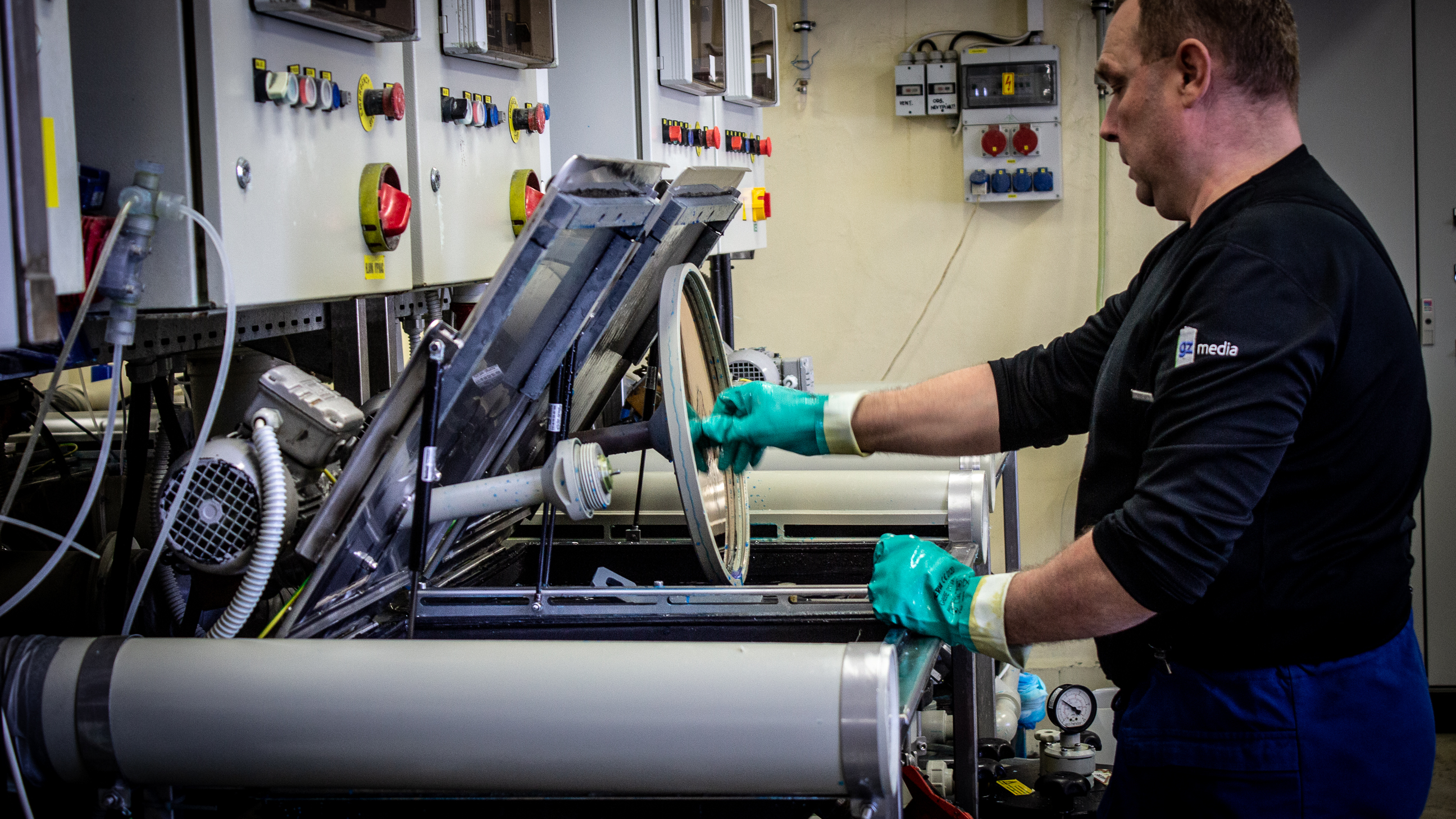Producing vinyl records using Direct Metal Mastering (DMM) technology involves not only cutting the grooves into a copper plate (which is described in detail on in the Mastering section) but also several other processes in order to produce the high-quality stampers utilized in the pressing process.
Cannot connect to Ginger Check your internet connection
or reload the browser
Cannot connect to Ginger Check your internet connection
or reload the browser
Cannot connect to Ginger Check your internet connection
or reload the browser
Production of blank DMM plates
 The first step in DMM technology is the production of the copper plate. In a galvanic bath, we plate a flat, non-magnetic steel polished disc with a 100 micron thick layer of high purity copper. The copper layer is necessary in order to enable the sound grooves to be properly cut into the surface with a diamond knife, ie neither too soft nor too hard. GZ purchased their DMM technology in 1985 directly from the German company Teldec, who had developed and launched the process in the early 80s. The advantage of manufacturing our own copper plates is the possibility to control and monitor the quality of the plates as well as the optimal adaptation to the capacity requirements of the production process.
The first step in DMM technology is the production of the copper plate. In a galvanic bath, we plate a flat, non-magnetic steel polished disc with a 100 micron thick layer of high purity copper. The copper layer is necessary in order to enable the sound grooves to be properly cut into the surface with a diamond knife, ie neither too soft nor too hard. GZ purchased their DMM technology in 1985 directly from the German company Teldec, who had developed and launched the process in the early 80s. The advantage of manufacturing our own copper plates is the possibility to control and monitor the quality of the plates as well as the optimal adaptation to the capacity requirements of the production process.
Engraving of matrix numbers and other information
 The mastered and cut DMM plates are sent to the Metalwork Department, where the matrix numbers are engraved into the DMM plates in the area between the run-out grooves. This number is the basic identification number which helps identify which plate and label belongs to which side of the record as well as identifying the production in our warehouse and internal database. The customer can also request to engrave other data such as a catalogue number, company name, small message, etc. into the run-out area. These engravings are transferred to the stampers and will be visible on all pressed records.
The mastered and cut DMM plates are sent to the Metalwork Department, where the matrix numbers are engraved into the DMM plates in the area between the run-out grooves. This number is the basic identification number which helps identify which plate and label belongs to which side of the record as well as identifying the production in our warehouse and internal database. The customer can also request to engrave other data such as a catalogue number, company name, small message, etc. into the run-out area. These engravings are transferred to the stampers and will be visible on all pressed records.
Production of stampers through electroforming
 The mastered, cut and engraved copper plates are then put through a process of thorough degreasing and rinsing with demineralised water and are immersed as a cathode in an electroforming bath consisting of a solution of nickel salt and other ingredients. An electric current flowing throughout the bath from the nickel anode to the cathode creates a deposit of nickel atoms onto the copper layer forming the required layer of metallic nickel. We then get a mirrored image (negative) of the plate after separating the accrued nickel layer,
The mastered, cut and engraved copper plates are then put through a process of thorough degreasing and rinsing with demineralised water and are immersed as a cathode in an electroforming bath consisting of a solution of nickel salt and other ingredients. An electric current flowing throughout the bath from the nickel anode to the cathode creates a deposit of nickel atoms onto the copper layer forming the required layer of metallic nickel. We then get a mirrored image (negative) of the plate after separating the accrued nickel layer,  therefore yielding an unformed stamper. We can repeatedly produce several stampers from the same copper plate over the course of a few years. After the completion of all necessary manufacturing processes, the copper plate is again thoroughly washed and covered with a thin layer of nickel, protecting the grooves from various environmental conditions, and then stored in our archives. Only one electroforming step is required to produce a stamper. This is one of the reasons why records produced using DMM are sonically very accurate.
therefore yielding an unformed stamper. We can repeatedly produce several stampers from the same copper plate over the course of a few years. After the completion of all necessary manufacturing processes, the copper plate is again thoroughly washed and covered with a thin layer of nickel, protecting the grooves from various environmental conditions, and then stored in our archives. Only one electroforming step is required to produce a stamper. This is one of the reasons why records produced using DMM are sonically very accurate.
Cannot connect to Ginger Check your internet connection
or reload the browser
Cannot connect to Ginger Check your internet connection
or reload the browser
Cannot connect to Ginger Check your internet connection
or reload the browser